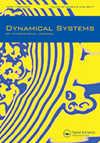The 0:1 resonance bifurcation associated with the supercritical Hamiltonian pitchfork bifurcation
IF 0.6
4区 数学
Q4 MATHEMATICS, APPLIED
引用次数: 0
Abstract
We consider the non-semisimple 0:1 resonance (i.e. the unperturbed equilibrium has two purely imaginary eigenvalues ( and ) and a non-semisimple double-zero one) Hamiltonian bifurcation with one distinguished parameter, which corresponds to the supercritical Hamiltonian pitchfork bifurcation. Based on BCKV singularity theory established by [H.W. Broer, S. -N. Chow, Y. Kim, and G. Vegter, A normally elliptic Hamiltonian bifurcation, Z. Angew. Math. Phys. 44 (3) (1993), pp. 389–432], this bifurcation essentially triggered by the reversible universal unfolding with respect to BCKV-restricted morphisms of the planar non-semisimple singularity (the is regarded as distinguished parameter with respect to the external parameter λ). We first give the plane bifurcation diagram of the integrable Hamiltonian on each level of integral in detail, which is related to the usual supercritical Hamiltonian pitchfork bifurcation. Then, we use the -symmetry generated by the additional pair of imaginary eigenvalues to reconstruct the above plane bifurcation phenomenon caused by the zero eigenvalue pair into the case with two degrees of freedom. Finally, we prove the persistence of typical bifurcation scenarios (e.g. 2-dimensional invariant tori and the symmetric homoclinic orbit) under the small Hamiltonian perturbations, as proposed by [H.W. Broer, S. -N. Chow, Y. Kim, and G. Vegter, A normally elliptic Hamiltonian bifurcation, Z. Angew. Math. Phys. 44 (3) (1993), pp. 389–432]. An example system (the coupled Duffing oscillator) with strong linear coupling and weak local nonlinearity is given for this bifurcation.与超临界哈密顿干草叉分岔相关的0:1共振分岔
我们考虑具有一个可分辨参数的非半简单0:1共振(即非摄动平衡具有两个纯虚特征值(和)和一个非半简单双零1)哈密顿分岔,它对应于超临界哈密顿干草叉分岔。基于[H.W.布罗尔,s.n。周,金,G.维特,一个正常椭圆的哈密顿分岔,Z. Angew。数学。[物理学报,44 (3)(1993),pp. 389-432],这种分岔本质上是由平面非半单奇点的bckv限制态射的可逆普遍展开引发的(该被视为相对于外部参数λ的区分参数)。首先详细地给出了可积哈密顿量在每一级积分上的平面分岔图,这与通常的超临界哈密顿量的草叉分岔有关。然后,我们利用额外的虚特征值对产生的-对称性,将上述由零特征值对引起的平面分岔现象重构为两个自由度的情况。最后,我们证明了典型的分岔情形(如二维不变环面和对称同斜轨道)在小哈密顿扰动下的持久性布罗尔,s.n。周,金,G.维特,一个正常椭圆的哈密顿分岔,Z. Angew。数学。物理学44 (3)(1993),pp. 389-432。给出了一个具有强线性耦合和弱局部非线性的耦合Duffing振子实例。
本文章由计算机程序翻译,如有差异,请以英文原文为准。
求助全文
约1分钟内获得全文
求助全文
来源期刊
CiteScore
0.90
自引率
0.00%
发文量
33
审稿时长
>12 weeks
期刊介绍:
Dynamical Systems: An International Journal is a world-leading journal acting as a forum for communication across all branches of modern dynamical systems, and especially as a platform to facilitate interaction between theory and applications. This journal publishes high quality research articles in the theory and applications of dynamical systems, especially (but not exclusively) nonlinear systems. Advances in the following topics are addressed by the journal:
•Differential equations
•Bifurcation theory
•Hamiltonian and Lagrangian dynamics
•Hyperbolic dynamics
•Ergodic theory
•Topological and smooth dynamics
•Random dynamical systems
•Applications in technology, engineering and natural and life sciences

 求助内容:
求助内容: 应助结果提醒方式:
应助结果提醒方式:


